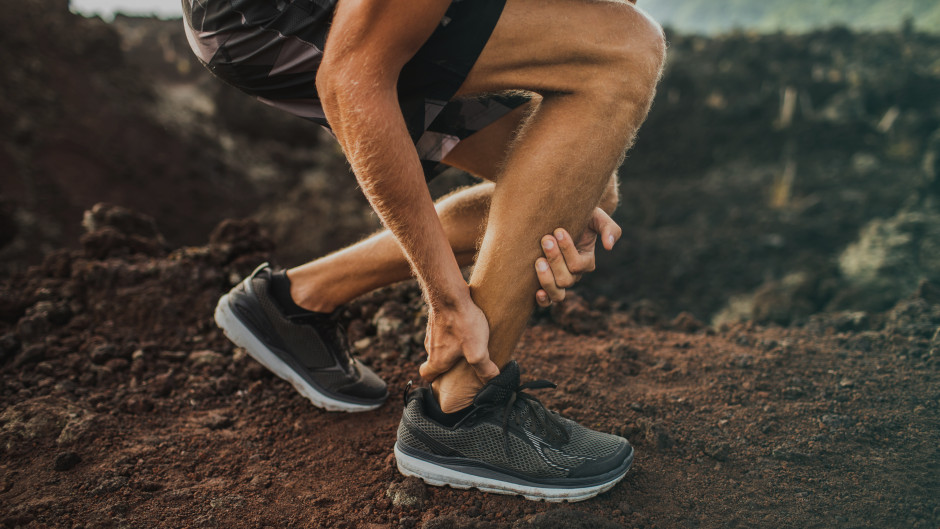Isometrics in Plantar fasciopathy
If you want to learn more about Plantar Heel Pain, then you can watch this lecture by expert Henrik Riel:
The aim of the blog
- Dissect the paper
- What we can directly take out from this study
- What can we indirectly take from this study
We will first discuss the paper by Riel, et al. 2018 (The effect of isometric exercise on pain in individuals with plantar fasciopathy.)
The author’s aim in this study was to investigate the ACUTE effect of isometric exercise on pain vs isotonic exercise vs walking in individuals with plantar fasciopathy.
Protocol
The participant attended three sessions over the course of two weeks. (The order of the group was randomized for all participants.) A minimum of 48-hour interval between sessions and they performed the sessions at approximately the same time.
Isometric exercise – Performed standing with the forefoot on a step. The participant was instructed to stand still with the ankle joint in neutral whilst balancing self on a wall or rail. 5 sets of 45-sec isometric holds
The load used is the heaviest possible load the participant was able to hold for 1 minute (If b/w was not enough, a backpack with weights was added)
Isotonic exercise – Performed standing with the forefoot on a step. Toes in max dorsiflexion with a towel underneath. The participant was instructed to perform heel-raise to maximal plantar flexion and to lower heel to max dorsiflexion.
- 4 sets of 8 reps with a load of 8RM. 3 second concentric, 2 second isometric, 3 second eccentric guided by a metronome
Walking – Participant instructed to walk at a pace similar to a pace they would at home. This was performed barefoot. They were instructed to walk 4 minutes (to match the duration during the exercises)
Outcome measure:
Primary – Pain – VAS immediately before and after each exercise/walk
Secondary – Change in pressure pain-threshold, change in thickness of plantar fascia using an ultrasound measured in mm.
Results
Isometric exercise was not better than isotonic exercise or walking at reducing pain with none of the exercises inducing an analgesic effect.

Comments on the general study.
I think this was a very well designed study. The study was prospectively registered and the treatment groups/protocols were designed in a way that was clinically applicable & pragmatic. (ie. not having to use an isokinetic machine to find what load to use). The sample size was small with 20 participants but Rio et al. (2015) study only had 6 participants.
Things to think about
The structure/makeup of the plantar fascia is not the same as tendons. Is that why isometrics were not effective?
The population used in this study had on average pain for approx 8 months compared to Rio et al. (2015)’s study, which was more acute.
What we can take away from this study is that the role of isometric exercise in plantar fasciopathy to reduce immediate acute pain cannot be recommended. This does not mean that isometric exercises are useless but it does not induce an analgesic effect. There are other studies to support the use of exercises and load through the tissue for this condition but the type of exercise may be less important than the overall load.
What we can indirectly take from the study?
I think from this study, we need to think more broadly in terms of taking a conclusion from one study (Rio et al. 2015) and applying it across a whole multitude of different (but arguably similar) conditions. This highlights the importance of not using one study but a collective of all the available research to help guide your treatment. Logical fallacies are not uncommon in our profession and we must be aware of our own biases and thinking. Just because something is proven wrong, does not automatically make your argument true.
Just some food for thought, until next time!
About the authors:
Adrian and Colin are Physiotherapist from Sydney (Australia) and Vancouver (Canada) respectively. Educating and sharing research was a passion of their even since studying Physiotherapy at University together. They continued to develop and challenge their thoughts and judgments whilst working in Private practice sector in Sydney.
Following Colin’s return his homeland of Canada. Adrian and Colin decided to kick-start an initiative to help new graduate Physiotherapists.
The Freshman Physio HERE aims to Empower new graduate clinicians with an evolving way of reasoning and bridge the gap from University to practice. With the primary goal of “Creating Better Clinicians."
If you want to learn more about Plantar Heel Pain, then you can watch this lecture by expert Henrik Riel:
Get 20% off for the yearly membership with the discount code: EASTER2022



